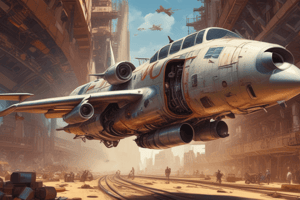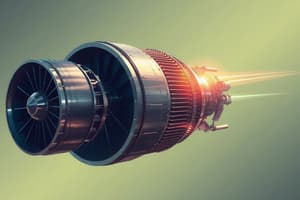Podcast
Questions and Answers
Where does the compressor discharge air enter?
Where does the compressor discharge air enter?
- Exhaust pipe flange assemblies
- Combustion chamber
- Torus turbine assembly
- Turbine plenum (correct)
What is the purpose of the turbine plenum?
What is the purpose of the turbine plenum?
- To house the turbine assembly
- To provide structural support for the unit
- To regulate lubrication system pressure
- To collect compressor discharge air (correct)
What is attached to the rear outer flange of the second stage compressor diffuser?
What is attached to the rear outer flange of the second stage compressor diffuser?
- Exhaust pipe flange assemblies
- Turbine plenum (correct)
- Torus turbine assembly
- Combustion chamber
What is the function of the torus turbine assembly?
What is the function of the torus turbine assembly?
How many paths of structural support are provided by the turbine plenum arrangement?
How many paths of structural support are provided by the turbine plenum arrangement?
What happens to the mass airflow in the turbine plenum?
What happens to the mass airflow in the turbine plenum?
What is the primary function of the turbine wheel in an APU?
What is the primary function of the turbine wheel in an APU?
What is the purpose of the reduction gear train in the accessory drive section?
What is the purpose of the reduction gear train in the accessory drive section?
What is the function of the sun gear in the planetary reduction gears?
What is the function of the sun gear in the planetary reduction gears?
What is the result of the high velocity gas flowing through the turbine nozzle?
What is the result of the high velocity gas flowing through the turbine nozzle?
What is the purpose of the torsion shaft in the accessory drive section?
What is the purpose of the torsion shaft in the accessory drive section?
What is the function of the planetary reduction gears in the accessory drive section?
What is the function of the planetary reduction gears in the accessory drive section?
What type of impeller is used in the second stage of the compressor?
What type of impeller is used in the second stage of the compressor?
How many bearings support the compressor/turbine shaft?
How many bearings support the compressor/turbine shaft?
Where is the single bronze bush located?
Where is the single bronze bush located?
How are the first and second stages of the compressor connected?
How are the first and second stages of the compressor connected?
What is the function of the crossover ducts?
What is the function of the crossover ducts?
Where is the turbine plenum chamber located?
Where is the turbine plenum chamber located?
What sequences electrical power to the fuel shut-off valve during APU start?
What sequences electrical power to the fuel shut-off valve during APU start?
What is the primary function of the rate control valve in the fuel system?
What is the primary function of the rate control valve in the fuel system?
How is the starter motor de-energized during APU start?
How is the starter motor de-energized during APU start?
What occurs when the centrifugal speed switch reaches 95% during APU start?
What occurs when the centrifugal speed switch reaches 95% during APU start?
What is the purpose of the fuel governor during APU start and on-speed conditions?
What is the purpose of the fuel governor during APU start and on-speed conditions?
What is the purpose of the secondary orifice in the fuel system?
What is the purpose of the secondary orifice in the fuel system?
Which electrical system component is responsible for igniting the fuel/air mixture?
Which electrical system component is responsible for igniting the fuel/air mixture?
What is the primary source of power for the APU electrical components during initial start and operation?
What is the primary source of power for the APU electrical components during initial start and operation?
At what fuel pressure does the secondary orifice open?
At what fuel pressure does the secondary orifice open?
What is the output capacity of the APU generator?
What is the output capacity of the APU generator?
What is the purpose of the APU electrical system during initial start and operation?
What is the purpose of the APU electrical system during initial start and operation?
What happens at point A in the APU start-up sequence?
What happens at point A in the APU start-up sequence?
What is the purpose of the 35% speed switch in the APU start-up sequence?
What is the purpose of the 35% speed switch in the APU start-up sequence?
What is the state of the APU at point D in the start-up sequence?
What is the state of the APU at point D in the start-up sequence?
What happens to the FCU at point E in the APU start-up sequence?
What happens to the FCU at point E in the APU start-up sequence?
What is the result of the APU reaching point E in the start-up sequence?
What is the result of the APU reaching point E in the start-up sequence?
What happens to the pneumatic thermostat at point E in the APU start-up sequence?
What happens to the pneumatic thermostat at point E in the APU start-up sequence?
What is the primary function of the Load Control Valve (LCV)?
What is the primary function of the Load Control Valve (LCV)?
What is the maximum percentage of compressor discharge air that the APU can provide without detriment to its performance?
What is the maximum percentage of compressor discharge air that the APU can provide without detriment to its performance?
What is the purpose of the three-way solenoid valve in the Load Control System?
What is the purpose of the three-way solenoid valve in the Load Control System?
What is the purpose of the pneumatic thermostat in the Load Control System?
What is the purpose of the pneumatic thermostat in the Load Control System?
Where is the Load Control Valve (LCV) mounted?
Where is the Load Control Valve (LCV) mounted?
What is the type of valve that the Load Control Valve (LCV) is?
What is the type of valve that the Load Control Valve (LCV) is?
What is the function of the three-way solenoid valve in the load control system?
What is the function of the three-way solenoid valve in the load control system?
What is the purpose of the load control solenoid in the load control valve operation?
What is the purpose of the load control solenoid in the load control valve operation?
What happens to the diaphragm (D) when the load control valve is opened?
What happens to the diaphragm (D) when the load control valve is opened?
What is the purpose of the ball valve (C) in the load control valve operation?
What is the purpose of the ball valve (C) in the load control valve operation?
What is the function of the spring tension in the load control actuator diaphragm chamber?
What is the function of the spring tension in the load control actuator diaphragm chamber?
What is the purpose of the lever pivoting at point (X) in the load control valve operation?
What is the purpose of the lever pivoting at point (X) in the load control valve operation?
What is the function of the three-way solenoid valve in the APU operating mode?
What is the function of the three-way solenoid valve in the APU operating mode?
What is the purpose of the acceleration limiter circuit in the FCU?
What is the purpose of the acceleration limiter circuit in the FCU?
What is the condition required for the load control circuit to be connected to the thermostat?
What is the condition required for the load control circuit to be connected to the thermostat?
What is the purpose of the air pressure regulator valve in the APU system?
What is the purpose of the air pressure regulator valve in the APU system?
What happens when an over-temperature occurs in the pneumatic thermostat?
What happens when an over-temperature occurs in the pneumatic thermostat?
What is the purpose of the load control valve in the APU system?
What is the purpose of the load control valve in the APU system?
Flashcards are hidden until you start studying
Study Notes
APU Major Sections
- The APU consists of three major sections: compressor, accessory drive, and power section.
- The compressor section consists of a two-stage centrifugal impeller compressor, diffusers, and ducting.
- The accessory drive section consists of a reduction gear train and housing.
- The power section consists of turbine, combustion, and exhaust components.
Compressor Section
- The compressor section has two stages: a double-sided double-entry impeller and a single-sided single-entry impeller.
- Both stages are located on a single shaft with the turbine.
- Air is transferred between the first and second stages by a series of crossover ducts that act as diffusers.
- The compressor/turbine shaft is supported by a single race ball bearing and a single bronze bush.
Turbine Nozzle Assembly
- High-velocity gas from the turbine nozzle is directed against the turbine wheel vanes, causing a change in gas flow direction.
- The resultant force produces the torque to rotate the turbine wheel.
- The torque developed by the turbine is returned through the shaft to rotate the compressor.
Turbine Wheel Assembly
- The turbine wheel is a radial inflow turbine wheel.
- The turbine wheel vanes are subjected to high-velocity gas, producing torque to rotate the turbine wheel.
Accessory Drive Section
- The accessory drive section consists of a reduction gear train and housing.
- A torsion shaft splines between the compressor shaft and the sun gear of the planetary reduction gears.
Power Section
- The power section consists of turbine, combustion, and exhaust components.
- The turbine plenum collects compressor discharge air in preparation for bleed air extraction or combustion.
- The turbine plenum is attached to the rear outer flange of the second stage compressor diffuser and is sandwiched between the exhaust pipe flange assemblies.
APU Start-up and Operation
- The start-up events of the APU are sequenced by the oil pressure sequencing switch, ignition system, fuel shut-off valve, and exhaust gas temperature (EGT).
- The APU accelerates to 35% speed, then 95% speed, and finally reaches on-speed condition.
- The fuel governor controls fuel supply during start-up and on-speed conditions.
- The electrical power is generated and supplied to the aircraft's systems during APU operation.
Electrical System
- The electrical system provides a means of starting the APU, controlling the APU fuel supply, igniting the fuel/air mixture, sequencing APU acceleration, and monitoring APU operation.
- The main components of the electrical system are generator, starter motor, tachometer, generator start meter, centrifugal speed switch assembly, and high energy ignition unit (HEIU).
Load Control Valve (LCV) Operation
- The LCV is a pneumatically operated butterfly valve that regulates the amount of air bled from the APU for aircraft services.
- The LCV system components include three-way solenoid valve, air pressure regulator, pneumatic thermostat, and LCV.
- The load control valve operates in closed and open modes, controlled by the load control solenoid, air pressure regulator, and pneumatic thermostat.
Pneumatic Thermostat
- The pneumatic thermostat is located in the APU exhaust flange and exposed to exhaust gas.
- The thermostat operates in two modes: start acceleration (no bleed air) and load controlling.
- The thermostat regulates the air pressure holding the load control valve in the open position, and closes the load control valve in case of over-temperature.
Studying That Suits You
Use AI to generate personalized quizzes and flashcards to suit your learning preferences.




